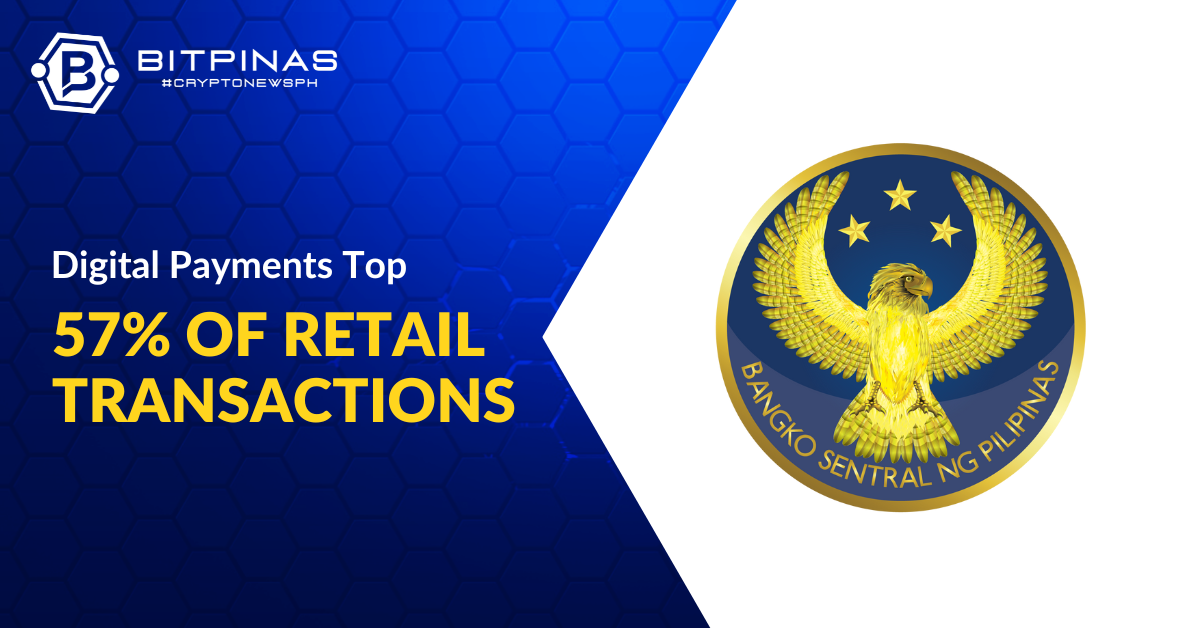Disclaimer: This article is for informational purposes only and does not constitute financial advice. BitPinas has no commercial relationship with any mentioned entity unless otherwise stated.
📬 Get the biggest crypto stories in the Philippines and Southeast Asia every week — subscribe to the BitPinas Newsletter.
Digital payments in the Philippines continued to gain ground in 2024, with electronic transactions now accounting for over half of all monthly retail payments, according to the Bangko Sentral ng Pilipinas (BSP).
Rise of Digital Payments
In the central bank’s latest report on the status of digital payments, the BSP revealed that the share of digital payments rose to 57.4% in terms of volume and 59.0% in value in 2024, an increase from 52.8% and 55.3%, respectively, in 2023.
It was noted that the steady growth reflects the country’s sustained shift toward cashless transactions, surpassing the BSP’s previous 2023 target of 50% digitalization in payment volume.

Government payments remained the most digitalized, with 97.2% of transactions processed electronically. Person-to-everyone payments followed at 72.2% by volume and 80.4% by value, while business-related payments reached 19.8% by volume and 38.6% by value.
The data highlights a significant jump from just 1% digital payment volume in 2013 and reinforces the role of policy initiatives, technological advancement, and increased consumer trust in driving adoption.
“This is more than just a continuation of past gains. It is a reaffirmation of our collective vision, of a future where every Juan and Maria, no matter where they are in the archipelago, can access and benefit from secure, reliable, and convenient financial services.”
Eli Remolona, Jr., Governor, Bangko Sentral ng Pilipinas
In addition, Remolona said the central bank remains focused on using technology and financial tools to both strengthen market connectivity and promote financial inclusion. He emphasized the importance of creating a supportive environment where regulated institutions and fintech companies can develop innovative, accessible, and consumer-oriented financial solutions.
“The latest numbers speak to our momentum. Digital payments now account for over 57 percent of retail transactions by volume. Beyond these headline figure lies our deeper challenge to ensure that digital payments are not just adopt but be integrated into the daily lives of every Filipino. We envision a future where digital becomes the default, not only because it is mandated but because the end users see real value in its convenience, security and the feeling of empowerment.”
Mamerto Tangonan, Deputy Governor, Payments and Currency Management Sector, Bangko Sentral ng Pilipinas
Key Contributors
Merchant, P2P, and B2B Transactions
The report noted that merchant payments accounted for 66.4% of digital transactions, followed by person-to-person (P2P) transfers (20.6%) and business-to-business (B2B) payments (6.2%), totaling over three billion digital transactions in 2024.
BSP highlighted that this growth was driven by broader use of QR Ph, InstaPay, and PESONet. InstaPay transactions rose 67.8% in volume and 46.3% in value, while PESONet’s additional clearing cycle improved B2B efficiency.

Retail Transactions
Among the 3.307 billion digital transactions in 2024, merchant payments accounted for 66.4% of volume, P2P transfers for 20.6%, and B2B payments for 6.2%. Merchant and B2B payments combined accounted for 72.6% of digital transaction volume in 2024.

BSP Issued Regulations
To support digital adoption, BSP released two circulars in 2024:
- Circular No. 1195: Sets turnaround times and notifications for electronic fund transfers to improve customer redress.
- Circular No. 1198: Establishes licensing and risk management rules for Operators of Payment Systems handling merchant payments.
Digital Payments Initiatives
Project Nexus
According to the report, the BSP continued its involvement in Project Nexus Phase 4, a cross-border payment initiative connecting domestic real-time payment systems of the Philippines, India, Malaysia, Singapore, and Thailand.
The project, led by the BIS Innovation Hub, aims to enhance international payments by establishing shared governance, infrastructure, and operational models.
Project Agila (CBDC Pilot)
Project Agila explores the potential of a wholesale Central Bank Digital Currency (CBDC) for inter-institutional payments, even when the country’s real-time gross settlement system, named PhilPaSS Plus, is offline. Findings from testing will shape the BSP’s future CBDC Roadmap.
Read related articles:
QR Ph Rebranding
QR Ph was rebranded to help users distinguish between payment types:
- InstaPay QR (with InstaPay logo) for P2P transfers
- QR Ph code (red-blue-yellow logo) for merchant payments
QR Ph remains the national standard under BSP Circular No. 1055.
Direct Debit System
The Direct Debit is a payment service designed to help customers manage recurring expenses, such as rent, loan payments, and insurance premiums, by allowing billers to automatically withdraw funds from their accounts.
BSP highlighted that the system simplifies the collection process for billers and reduces the chances of missed or late payments for users.
The system is currently in the testing phase and is set for pilot launch this year.
Request-to-Pay (R2P)
The R2P InstaPay Cash-In allows users to fund an account via a simple request, without logging into another bank or e-wallet. This simplifies top-ups and broadens access to digital cash-in services. Commercial launch is planned in 2025.
Automated Fare Collection System (AFCS)
In partnership with the Department of Transportation, the BSP supports the AFCS to enable QR-based and contactless card payments for public transportation. Interoperable QR payments across modes of transit are planned for full rollout by 2027.
ISO 20022 Adoption
To modernize payment messaging, BSP is transitioning to the ISO 20022 standard.
The central bank noted that the global format improves data richness and accuracy, supporting faster settlement, better consumer redress, and more robust risk management.
This article is published on BitPinas: The Future is Cashless? 6 of 10 Retail Payments in 2024 are Digital: BSP Data
What else is happening in Crypto Philippines and beyond?


دیدگاهتان را بنویسید